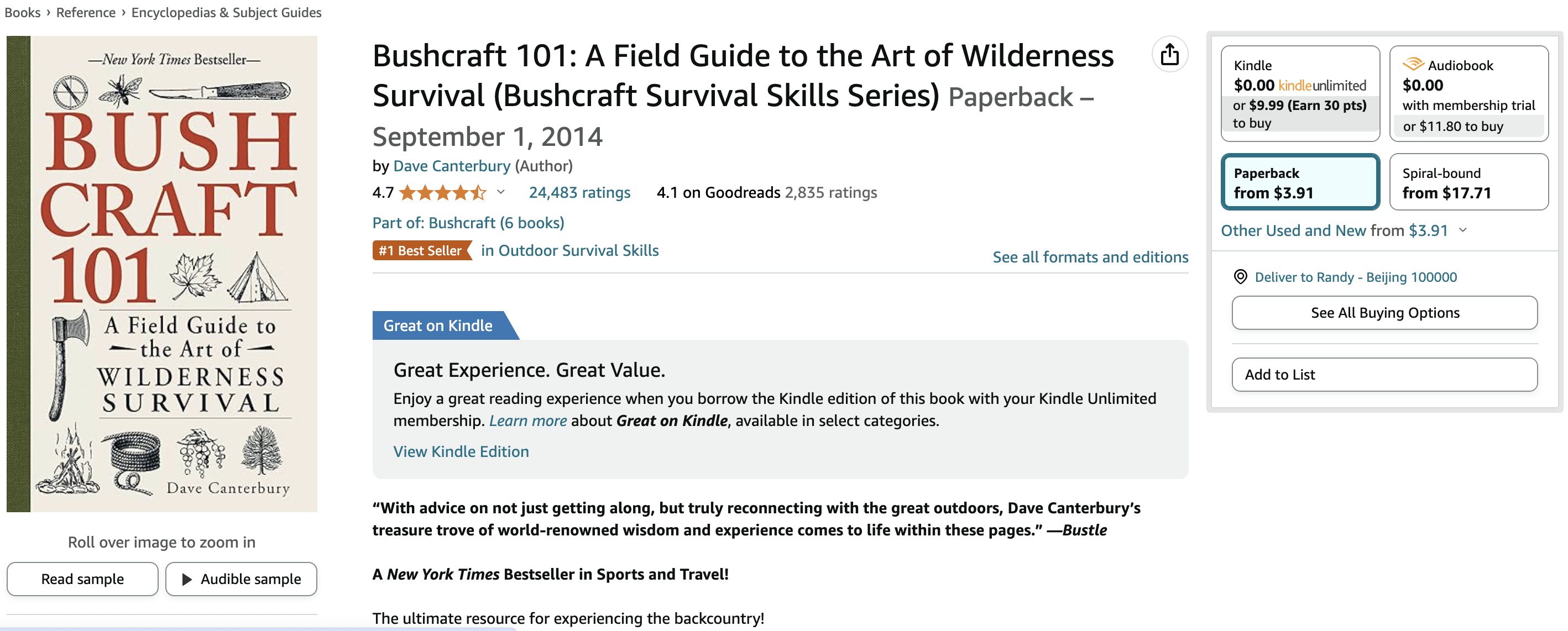Bushcraft 101: Level Up Your Wilderness Skills
I still remember the first time I watched Alone. It was the seventh season, where contestants braved the Arctic Circle, facing the challenge of surviving 100 days in a harsh environment. The last one standing would win a million dollars. At the end, the invincible Roland Welker won the game. As I watched, my mind kept drifting back to the first survival book I ever read, which is “Bushcraft 101: A Field Guide to the Art of Wilderness Survival” by Dave Canterbury. Roland’s strategies and choices in the face of adversity echoed the lessons from that book, creating a fascinating connection between his actions and the chapters I once studied.
Well, today I’m not here to talk about the TV show. I’m here for the book.
This book isn’t your dad’s dusty old Boy Scout manual. It’s jam-packed with way more than just basic knot-tying (although that’s covered too, don’t worry). We’re talking serious skills that could actually save your bacon – or should we say, your jerky – if you ever get lost on a hike or camping trip. Think about it, how cool would it be to tell your friends you survived a night in the woods because you knew how to build a fire and find edible plants?
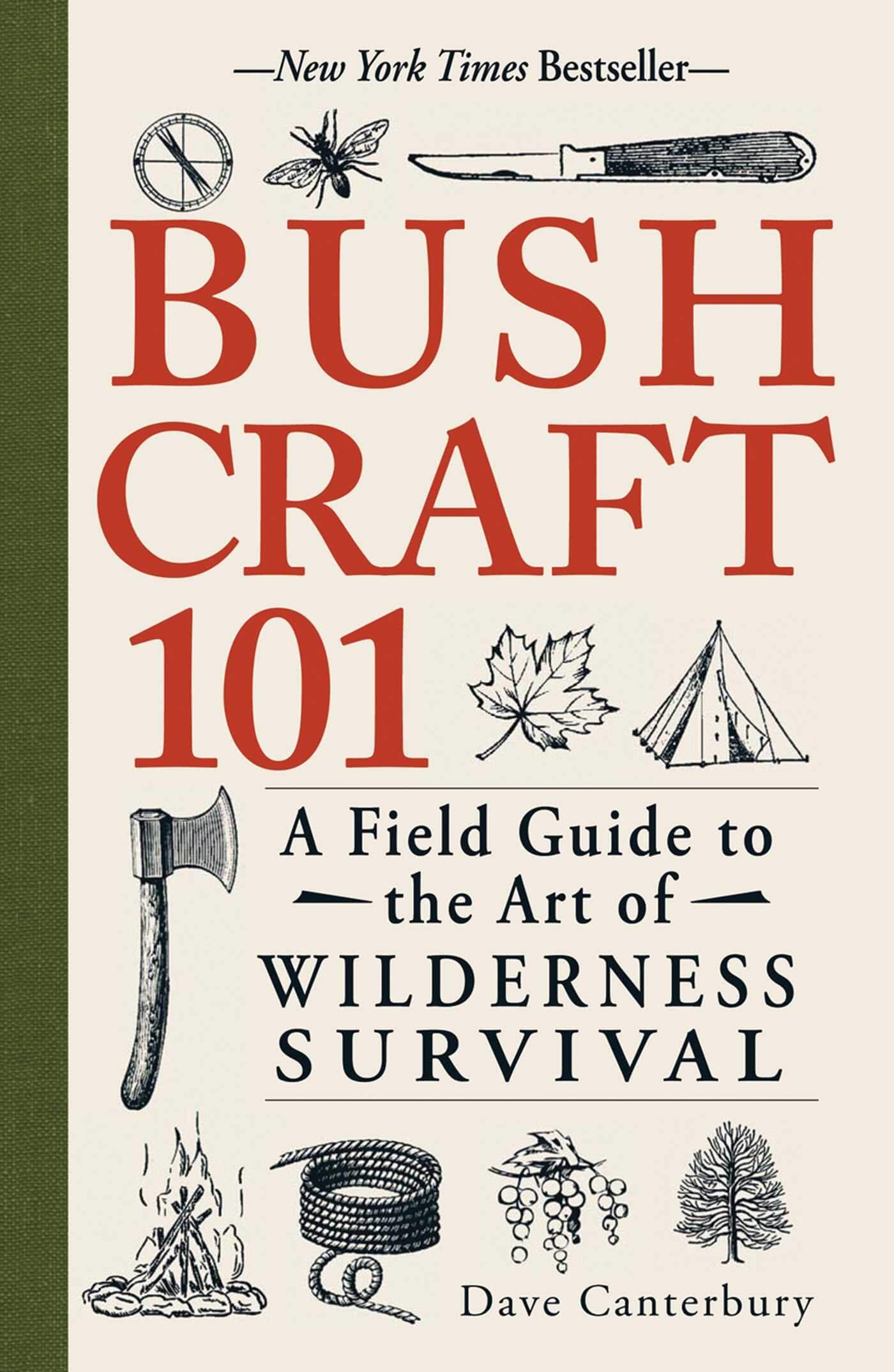
bushcraft-101 A Field Guide to the Art of Wilderness Survival
Beyond Boy Scouts: Practical Skills for Real Situations
Unlike some other survival guides that just throw random tips at you, Bushcraft 101 focuses on the practical stuff you’ll actually need in a pinch. Let’s say you take a wrong turn on a hike in Yosemite and end up deeper in the woods than planned. This book will show you exactly how to build a sturdy emergency shelter using branches and leaves, way better than that flimsy tent you forgot to stake down properly.
The book even has a whole section dedicated to firecraft, with clear pictures and even step-by-step instructions on how to build a fire from scratch using materials you can get in the forest. No more relying on that lighter that mysteriously ran out of fuel just when you needed it most!
Dive into the contents of “Bushcraft 101”
Your Pack & Pack Baskets: The book might suggest packing a multi-tool, which has many functions in one compact device. For example, it can be used to cut small branches, open cans, and even has a small saw.
Tools, Batoning, Knife Care, Saw Safety: The book could provide a step-by-step guide on how to safely use a knife to split wood (batoning), which is useful for making kindling for a fire.
Charring Tins, Firecraft, Starting Materials: The book might demonstrate how to use a char cloth (a piece of fabric charred in a tin) to catch a spark and start a fire.
Navigating Terrain, PAUL Positive Azimuth Uniform Layout Method: The book could explain how to use the sun and stars for navigation, and how to use the PAUL method to layout a path using landmarks.
Understanding Trap Components, Modern Traps, Water Trapping, Tips and Tricks for Successful Trapping: The book might show how to set up a simple snare trap to catch small game for food.
Always Carry Wedges, Lashings Bindings and Toggles: The book could illustrate how to use a wedge to split wood, and how to use lashings to build a shelter.
Cooking Irons, Stoves and Burners, Bush Recipes: The book might share a recipe for a simple stew that can be cooked over a campfire using foraged ingredients.
Wool Blankets: The book could provide tips on how to use a wool blanket as a makeshift shelter or to keep warm during a cold night.
Shelter Building Techniques
Some Guide on building emergency shelters using natural materials. Remember Roland Rock House from Alone S7? That rock house shelter could make all the difference. This chapter covers basically everything a beginner should know about his shelter that protect you from the elements and keep you cozy.
Tarps and Tarp Tents
Tarps are your go-to for quick, versatile shelters. They’re like the Swiss Army knife of camping gear. You can rig them up between trees as a basic lean-to or create an A-frame tent. In the book, you’ll find different setup methods to suit various conditions. For instance, when caught in a sudden downpour in the Smoky Mountains, a properly pitched tarp can save you from getting drenched.
Polypropylene and Silnylon
These materials are champions in the lightweight shelter game. Polypropylene is cheap and water-resistant, making it a good choice for beginners. Silnylon is the high-tech option: super light and strong. Imagine hiking the Appalachian Trail with a Silnylon tarp that hardly adds any weight to your pack but keeps you dry during those unexpected rain showers.
Canvas
Canvas is old-school but gold. It’s tough, breathable, and great for more permanent setups. Think of the classic canvas tents you see at historical reenactments or scout camps. If you’re planning a base camp for a week-long adventure in the Adirondacks, a canvas tent could be your sturdy, reliable home away from home.
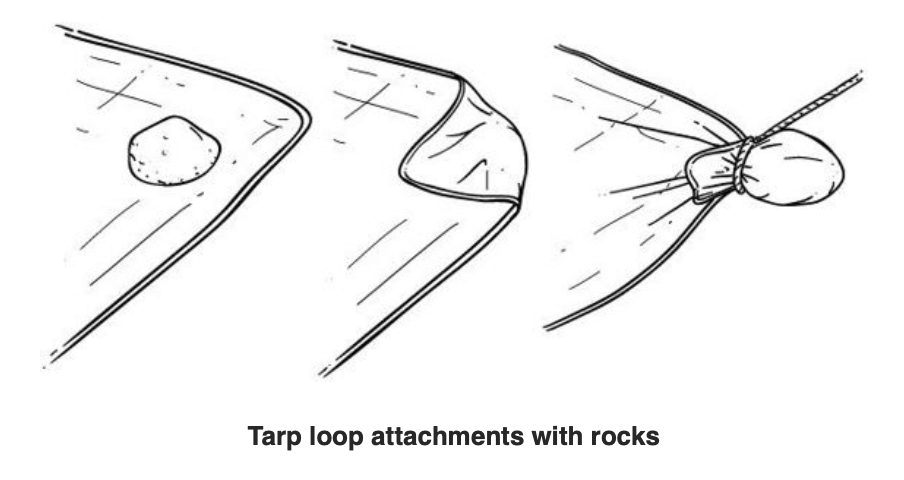
tarp loop attachments with rocks
Oilcloth
Oilcloth is canvas treated to be water-resistant. It’s durable and perfect for making tarps and ground covers. If you’re camping out in a place like the Everglades, where rain can come suddenly and heavily, oilcloth can provide a reliable barrier against the wet ground.
Ground Pads
Sleeping on the ground can be a cold and uncomfortable experience. Ground pads are lightweight and add a layer of insulation between you and the earth. When you’re camping in places like the Rockies, where the nights can get chilly, a ground pad can make a huge difference in keeping you warm and comfortable.
Browse Bags
A browse bag is a clever, natural solution for making a comfy bed in the wild. It’s essentially a sack you stuff with leaves, pine needles, or soft grasses. If you ever find yourself having to set up an impromptu camp, like in the dense woods of the Pacific Northwest, a browse bag can provide a surprisingly comfy night’s sleep.
Emergency Thermal Blankets
These shiny, foil-like blankets are lifesavers. They reflect your body heat back to you, making them essential for cold weather emergencies. Lightweight and compact, they’re a must-have for your backpack, especially when adventuring in unpredictable climates like those in the Sierra Nevada.
Hammocks
Hammocks are fantastic for keeping you off the ground, away from bugs, and out of the damp. They’re especially handy in humid or wet places like the bayous of Louisiana.
Sleeping Bags
Choosing the right sleeping bag is crucial. The book breaks down the different types, from summer bags to winter ones. If you’re camping in the Grand Canyon, where temperatures can vary wildly, knowing how to pick the right bag for the season can keep you snug and warm at night.
Wool Blankets
Wool blankets are a timeless favorite because they’re warm even when wet and incredibly durable. They’re perfect for adding extra warmth on cold nights, or for sitting around the campfire without worrying about sparks damaging your gear.
Natural Shelters
Sometimes you have to rely on what nature provides. The book covers how to build shelters using branches, leaves, and even snow. If you find yourself in a survival situation, like being lost in the vast wilderness of Alaska, knowing how to construct a natural shelter could be a lifesaver. Two key types of natural shelters you’ll learn about are the A-frame shelter and the debris hut.
A-frame Shelter: This is one of the simplest and most effective shelters to build. All you need are some sturdy branches for the frame and plenty of leaves, pine needles, or other foliage for insulation. The book guides you through finding the right location, such as between two strong trees, and assembling the frame. Once you’ve got the structure, you can cover it with leaves and branches to keep out the wind and rain.
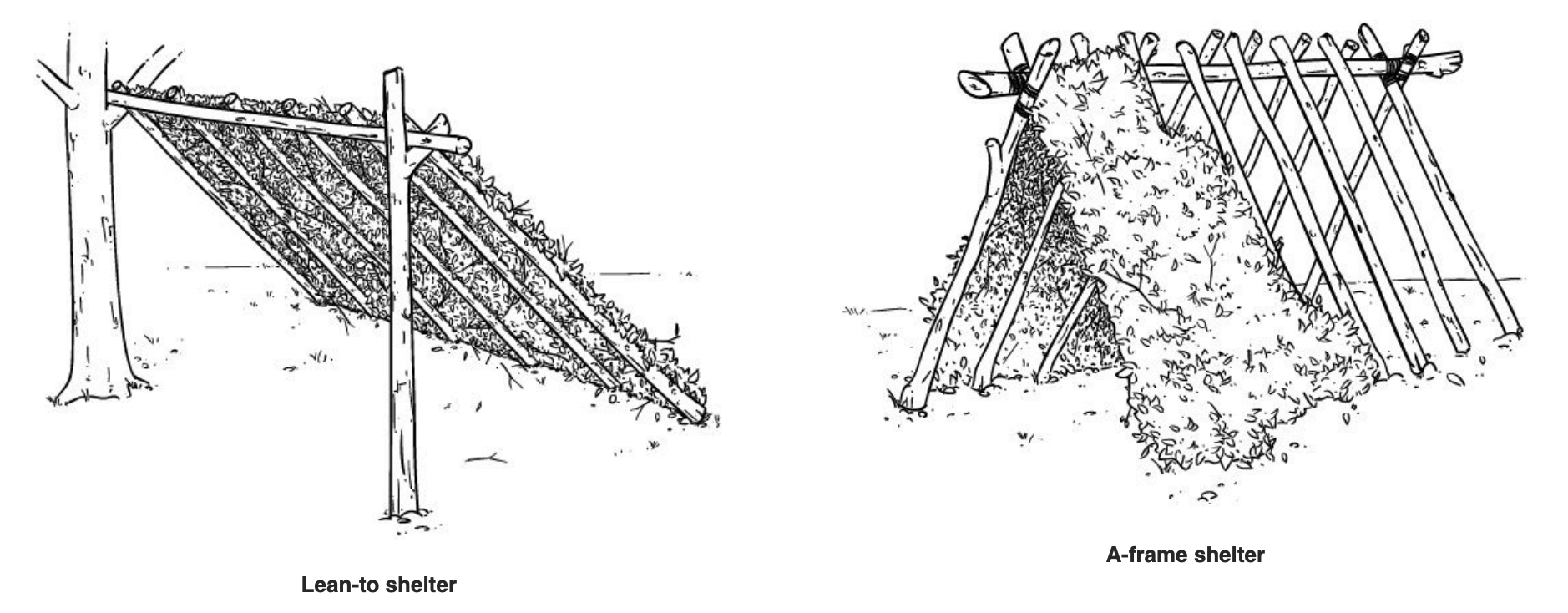
a frame shelter
Debris Hut: The debris hut is another excellent natural shelter, especially in colder climates. It’s designed to keep you warm by using your body heat to heat the small, insulated space. The book explains how to build this by creating a framework with sticks and covering it thickly with leaves, grass, and other natural materials. You crawl inside, and the insulation provided by the debris helps retain your body heat. This type of shelter is crucial if you’re caught in freezing conditions, like those you might encounter in the Rocky Mountains during an unexpected cold snap.
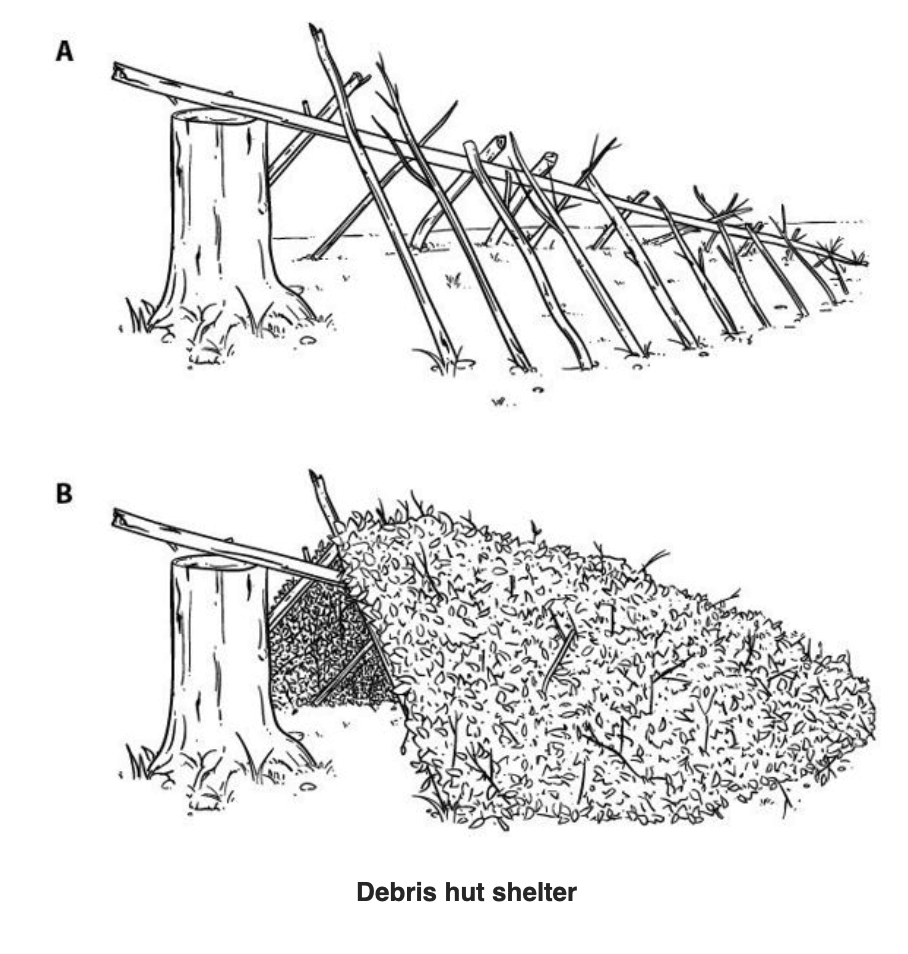
Debris hut shelter
Tips and Tricks for Smarter Coverage This section is packed with practical advice. For example, always set up your shelter with the entrance facing away from the wind to keep rain out. Or use your rain poncho as an extra layer over your sleeping bag for added warmth. These are the kinds of tips that can make your camping experience more enjoyable and keep you safe in unexpected situations.
This section is packed with practical advice. For example, always set up your shelter with the entrance facing away from the wind to keep rain out. Or use your rain poncho as an extra layer over your sleeping bag for added warmth. These are the kinds of tips that can make your camping experience more enjoyable and keep you safe in unexpected situations.
Mastering Firecraft
“Mastering Firecraft” in “Bushcraft 101” covers everything you need to know about starting and maintaining a fire in the wilderness.
Starting Materials Before you can build a fire, you need to gather the right materials. This part of the chapter explains what you need to get started, from tinder to kindling to fuelwood. Think of tinder as the tiny, dry stuff like leaves, pine needles, or even pocket lint that catches fire easily. Kindling includes small sticks and twigs, while fuelwood consists of larger logs that keep the fire burning longer. The book emphasizes that dry materials are your best friend here—wet wood is much harder to ignite.
Fire Lays Once you’ve got your materials, the next step is arranging them properly. This section covers different types of fire lays, or ways to set up your fire for different purposes. For instance, a teepee fire lay is great for quick, hot flames, while a log cabin lay is better for a longer-lasting fire.
Long Fires If you’re planning to stay up late under the stars or need to keep warm through a cold night, you’ll want to know about long fires. These are built to burn for hours without needing much maintenance. The chapter explains how to set up a long fire by laying logs parallel to each other and adding more as needed.
Dakota Fire Pits
The Dakota fire pit is a more advanced technique that involves digging two holes in the ground. One hole holds the fire, and the other serves as a vent to draw in air. This setup creates a hotter, more efficient fire and is great for cooking because it produces less smoke and wind doesn’t affect it as much. The book provides detailed instructions and diagrams to help you dig and use your own Dakota fire pit.
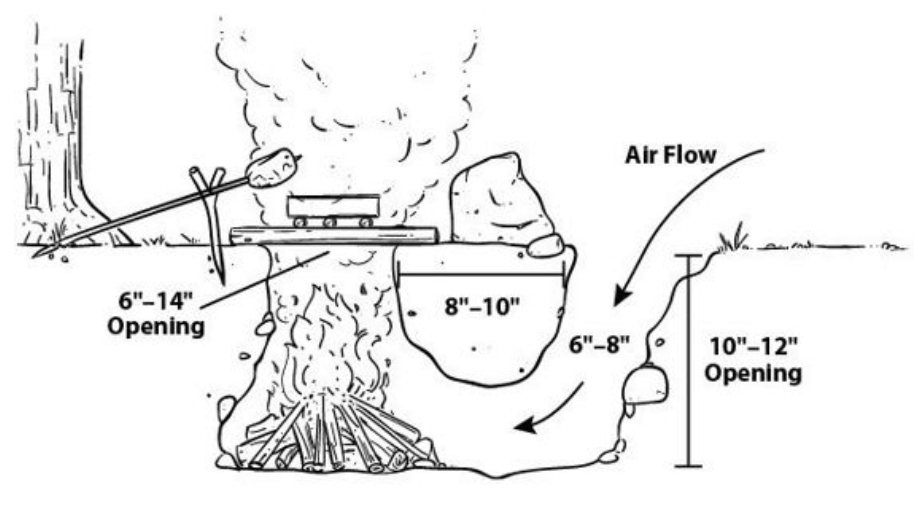
Dakota fire hole
Keyhole Fires Finally, the chapter covers keyhole fires, which are perfect for cooking. Imagine a regular fire with a narrow trench extending out from it—this trench is your “keyhole.” You can push hot coals from the main fire into the trench to create a controlled cooking area. It’s like having a built-in stove right in your campfire. The book explains how to build and use a keyhole fire, so you can whip up some tasty wilderness meals.
Bushcraft vs. other Survival Guide: What’s the Difference?
Okay, so you might be wondering, what’s the difference between this book and a regular survival guide? Survival guides are great for teaching you basic emergency skills, but Bushcraft 101 goes way beyond that.
Imagine you’re flipping through two different books. One, a classic survival guide, has sections on signaling for help, building a basic SOS shelter, and maybe purifying questionable water sources. It’s great for emergencies – the kind of stuff you hope you never need, but are glad to know in a pinch.
Now, crack open Bushcraft 101. This book dives deeper, teaching you how to truly live off the land, not just survive until rescue arrives. Sure, it covers the essential shelter-building you’d find in any guide, but Bushcraft 101 goes a step further. It teaches you how to identify different types of trees and their suitability for building a sturdy, long-lasting shelter – a crucial difference if you’re stuck in the wilderness for more than a night.
Let’s take firecraft, for example. A typical survival guide might show you how to use a magnifying glass and tinder to get a spark. Bushcraft 101 goes way beyond that. It delves into different fire-starting methods using natural materials like flint and steel, or even a bow drill. The book even teaches you how to create different fire types for specific needs – a signal fire to attract attention, or a controlled cooking fire for a proper wilderness meal.
Here’s the key difference: survival guides are like those little first-aid kits you carry – essential for emergencies, but limited in scope. Bushcraft 101 is like a fully stocked medicine cabinet. It equips you with a broader range of skills to not just address immediate problems, but thrive in a challenging environment.
Bonus: About the Author
The author of the book “Bushcraft 101” is Dave Canterbury. He is a survivalist expert and the co-owner and supervising instructor at the Pathfinder School, which has been named one of the Top 12 Survival Schools in the United States.
Dave Canterbury was born on September 19, 1963, in Indianapolis, Indiana. He has been interested in the outdoors his whole life, which led him to join the U.S. Army in 1981, where he served for six years2. After leaving the military, he worked in various private-sector jobs, including a reptile farm and as a commercial fisherman/diver in Florida12. These experiences allowed him to apply the skills he learned in the military to his real-life work.
Canterbury is a survival expert with almost 40 years of experience in the outdoors. He has put his knowledge to good use by writing guide books, instructing at schools, creating educational videos, and selling high-quality gear at his online store. He is the founder and co-owner of the Pathfinder School in southeast Ohio, where he teaches survival techniques.
He also co-starred on the reality television show Dual Survival for two seasons (2010–11) which aired on the Discovery Channel. On the show, Canterbury demonstrated various survival skills. In 2015, Canterbury co-starred in a survival series called Dirty Rotten Survival, which aired on the National Geographic Channel.
However, it’s worth noting that Canterbury came under scrutiny when it was found that he had misrepresented his military record. Despite this controversy, his extensive experience and knowledge in survival skills and bushcraft are undeniable.
So, ditch the boring survival guides and outdated Boy Scout manuals. If you’re serious about exploring the wild with confidence and learning real-world skills that could actually come in handy, Bushcraft 101 is the ultimate guide to get you started on your bushcraft adventure!
